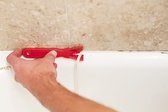
Patience is key to making it super simple.
How to remove bathroom caulk? With patience — and plenty of it.
It’s not hard to do, but if you rush it, you’ll regret it. Plus, a little patience pays off by making the job much, much easier.
How to Remove Old Caulk
Step 1. Apply a caulk remover, such as 3M caulk remover or McKanica silicone caulk remover gel. Then be patient. Very patient. The directions say to wait 2 or 3 hours, but the longer you wait, the easier it will come off. Overnight is good. If it’s a particularly tough job — such as very old, hardened caulk or multiple layers — wait 24 hours.
Step 2. Use a caulk remover tool to pry the caulk loose. (See video below.) Pros use a utility knife or blade, but don’t be tempted unless your hands are as steady as a surgeon’s. Otherwise, you could damage the tub, sink, shower, or wall you’re trying to improve. Most of the caulk should come off easily in long strips, although you might need to use needle-nose pliers or tweezers to pull out some bits.
{{ include_video remove-caulking }}
By the way, did you know that the word “caulk” originated from boat builders who needed something to seal their boats? Today, most manufacturers label home-use caulk as “sealant.”
Step 3. Using a small putty knife, toothbrush, and/or the hook end of a 5-in-1 painter’s tool (see picture below), scrape any remaining bits of caulk lose (this step, too, requires a bit of patience).
Step 4. Clean the surface using alcohol. Then kill any mold or mildew with a mixture of 1/3 cup bleach to 1 gallon of water. Allow to completely air dry (again, patience) before applying new caulk.
TIP: If you’re planning to re-caulk a tiled shower or bathtub wall, deep clean the tile before you remove the old caulk. Soap scum and other surface grime can inhibit the caulk’s ability to adhere. You don’t want water to get behind the tile and into your wall, which can create a nasty mold and mildew problem.



